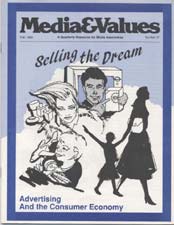YOUTH: Material World Puts Price Tag on Values
|
This article originally appeared in Issue# 37
|
Teens grow up in a commercial world.
By the time the average adolescent graduates from high school, he or she will have watched nearly 900 thousand television commercials. To this add radio spots, magazine ads, billboards... no wonder teens feel so very much at home wandering through shopping malls looking at price tags.
"Mall-lingering," as William Kowinski calls it in The Malling of America, utilizes the preprogramming youth already have as consumers. Modem merchandising simply puts the finishing touches on their development as hard-core, lifelong shoppers.
Commercials gladly tell youth what to value in society. Everything is measured in terms of money. Intangibles with no dollar sign, including values like integrity, trust and sincerity must not be worth much. A material world shows little respect for voluntarism, altruism, or sacrifice.
Commercials also tell youth about themselves. For a commercial to work, the audience must accept two premises: first, that life as it exists is inadequate and inferior, and second, that improvement can be obtained through a purchased product or service.
Think of it. The commercial must encourage young viewers to identify those inadequacies in their own lives. What a learning for young people still not sure who they are or where they fit in. What a message to hear almost 900,000 times.
Oh yes, the commercial does present a perfect role model who has been aided by the savior product... But what if the results don't change the life of the youth who tries it?
Well, it worked for the model - everyone saw that. The fault must be with the individual. Even with the miracle product, the individual is still inadequate - it's even worse than the "before" scenario.
To disprove such faulty logic, tell the young people you know that you are going to give them a free 30-second spot during the Super Bowl. The product to be advertised is the person sitting beside them in their youth group. Divide into teams of two, giving each person two minutes to interview the other. Suggest they take endless notes about the beautiful qualities of their partner. Let each one deliver an enthusiastic commercial on why the person they interviewed is the best person in the world to know.



